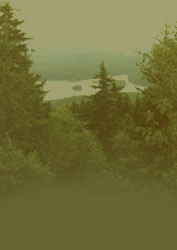|
Do you have something
happening in your corner of Washington? - Please call a member
or e-mail your observations to have them included here
December:
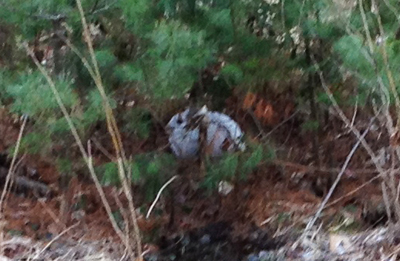
Snowshoe Hare picture by Jed
Schwartz
Jed was out for a walk in a wooded area
and was lucky enough to see a Snowshoe Hare
recently. The only reason he was able to spot him was because
the snowshoe hare had his white winter coat on and we had
no snow cover on the ground. His winter disguise was making
him easy to spot among the brown ground cover of fallen leaves
and brush. The hare didn't grasp right away that Jed could
see him so clearly, so when Jed moved in closer to get a picture
he realized he better move along and hopped away at top speed
zigging through the woods. If he still had his soft brown
summer coat on he would have blended in beautifully, but along
with the shorter days of fall he molted to his white coat
over a ten week period. The lack of snow made him more vulnerable
to being spotted.
Snowshoe hare are found throughout New England, across Canada,, and south to the Appalachian and Rocky
Mountains. In New Hampshire they are most abundant in the northern three counties. In New Hampshire,
snowshoe hares can be hunted from October to March.
They have large hind feet with both front and hind feet heavily furred in winter. Their toes
spread out like a "snowshoe", enabling them to hop about in deep snow. Both sexes look similar,
although females are slightly larger.
Snowshoe hare are active year-round, mostly at dawn, dusk, or at night. They seek shelter
next to a ledge or large rock, or under tree roots, hollow logs, or fallen trees. This
shelter will be used by the same hare throughout the year. They are active within a core
area of 5-10 acres; they may range up to 25 acres.
They breed from March to August, producing up to four litters
per year. Their young, known as "leverets," average three
per litter. Unlike rabbits, hare are born fully-furred, with
eyes open. They begin hopping at one day old.
In summer hare eat clover, grass, dandelions, berries, and ferns. In winter they
shift to twigs, buds, tender bark of shrubs and trees, and stems of bushes and
saplings including aspen, alder, spruce, fir, hen-dock, birch, willow, and pine.
Lowland spruce-fir forests with dense softwood understories and a mix of hardwoods are ideal habitat.
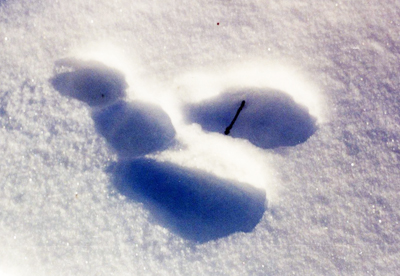
NPS photo by Donna DiFalco
Keep your eyes peeled for the snowshoe hare when you are walking in the woods this winter.You may just see his tracks in the snow or a pile of scat but if you are really lucky you
might catch a glimpse of this elusive animal.
Information on Snow
Shoe Hares found at:
NH Fish and Game
November:
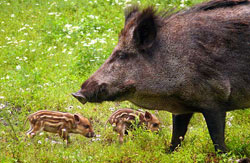
Feral pig picture by
Joerg Mikus
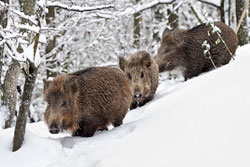
Feral pigs picture by
Scattoselvaggio
Yikes! Wild Boars in our
back yard.
Recently Arin read that wild pigs are found in New Hampshire.
Carol said she thought they were escapees from Corbin Park
in Croydon. She is right, the state Fish and Game Department
considers them escaped private property and you need permission
from the owner to hunt them.
Since their introduction to North America, wild pigs have
become one of the more serious wildlife problems in the United
States. A confirmed feral swine population in New Hampshire,
primarily in Grafton, Sullivan and Cheshire Counties, presents
a unique management challenge.
Natural range expansion and illegal introductions, coupled
with the extreme adaptability of feral swine, fuel the continued
spread of this destructive animal. There is help through the
state if you experience damage to your property or agriculture,
due to these wild pigs. To report feral swine damage or sightings,
contact:
Tony Musante at 603-223-6832, USDA/APHIS-Wildlife Services, 59 Chenell Drive Suite 7, Concord, NH 03301
In southwest New Hampshire, where the vast majority of our
feral boar exist, they are considered property of Blue
Mountain Forest Association, a privately owned preserve
located in Croydon, N.H (Corbin Park). Permission is required
to hunt free-ranging wild boar that escape from their property.
If granted permission (which typically is granted), you need
to have a current regular N.H. hunting license, and you must
hunt within legal hunting hours.
Corbin Park has an interesting story - it
is a private, enclosed shooting preserve with a very limited
membership.
The 24,000-acre preserve was founded in 1890 by Austin Corbin
II, a Newport native who grew to prominence in the late 1800s
as a founder of modern American banking.
Corbin used his fortune to buy up as much land as he could
in the Croydon-Grantham area to establish a gigantic hunter’s
playground, Originally, it was stocked with bison, white-tailed
deer, black-tailed deer, mule deer, European red deer, bighorn
sheep, moose, antelope, caribou, Himalayan mountain goats,
pheasants and wild boar from the German Black Forest.
The bison, deer, elk and boar all flourished, but the pheasants
flew over the fences and the rest of the species proved unable
to survive. Corbin Park once had the largest bison herd in
the country, and supplied bison and deer to refuges, parks
and zoos all over the U.S.
Information on wild boar found
at: NH Fish
and Game
Information on Corbin Park found
at: B Meyette
More information on wild boar
damage from USDA at:
USDA
October:
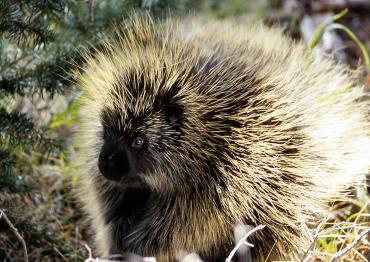
Porcupine picture from
US Parks
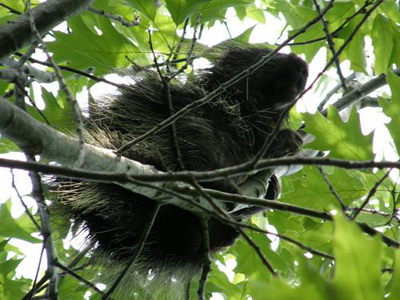
Porcupine picture from
NH Mountain Hiking
Watch out for Porcupines
this time of year, they are on the move!
The porcupine is a rodent with black to brownish-yellow fur
and strong, short legs. It has hairless soles on its feet
that help it climb trees. It has a round body, small ears
and a small head, but the most recognizable feature of the
porcupine is its quills. A porcupine may have as many as 30,000
quills. The quills are hairs with barbed tips on the ends.
The porcupine has quills on all parts of its body, except
for its stomach. The longest quills are on its rump and the
shortest quills are on its cheeks.
The porcupine uses its quills for defense. It cannot shoot
its quills but when a predator approaches, the porcupine will
turn its back, raise the quills and lash out at the threat
with its tail. If the porcupine hits an animal with its quills,
they become embedded in the animal. The porcupine is not an
aggressive animal and it will only attack if it is threatened.
Porcupines mate in late summer and early fall. Seven months
after mating the female gives birth to a single baby. When
the baby is born, its quills are soft and they harden about
an hour after birth. The baby porcupine is called a porcupette!
The porcupine is a solitary animal, although it may den with
other porcupines in the winter. It makes its den in caves,
decaying logs and hollow trees. The porcupine doesn't hibernate,
but stays active all winter. It may stay in its den during
bad weather, though. The porcupine is a good swimmer and its
hollow quills help keep it afloat! It is also an excellent
tree-climber and spends much of its time in trees. The porcupine
is an herbivore and it eats leaves, twigs and green plants
like skunk cabbage and clover. In the winter, it may eat bark
and loves to chew on salty wood.
It is a very vocal animal and has a wide-variety of calls
including moans, grunts, coughs, wails, whines, shrieks and
tooth clicking.
Keep a lookout for the porcupine when you are taking a walk
this time of year, especially if you have your dog with you!
Information found at:
NHPTV Natureworks
September:
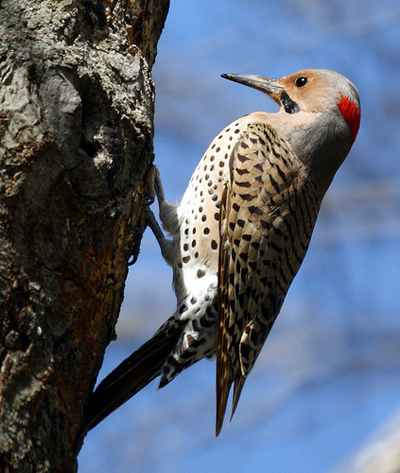
Flicker picture from
NJ Birds
Arin said she has seen quite a few Flickers,
recently.
This flashy bird is actually a large brown woodpecker about
12 inches in size. Flickers appear brownish overall with a
bright white rump patch that’s conspicuous in flight and often
visible when perched. With a closer look you’ll see the brown
plumage is richly patterned with black spots, bars, and crescents
with a black "bib" on its upper chest. Males have a black
or red "mustache" that runs from its bill down to its cheek.
The undersides of the wing and tail feathers are bright yellow.
The Flicker is the only woodpecker in North American that
commonly finds food on the ground, where it often forages
for ants and beetle larvae. It will sometimes perch on tree
limbs to eat berries. The flicker's diet is mostly insects,
including ants, but they also eat termites, beetles, caterpillars,
fruits, berries, seeds and nuts.
The Northern Flicker can be found in open forests, woodlots
and groves and is common in parks and gardens. They build
their nests in holes in trees, telephone poles or birdhouses.
Like many woodpeckers, its flight is undulating. The repeated
cycle of a quick succession of flaps followed by a pause creates
an up and down rollercoaster effect.
During courtship, flickers peck or "hammer" on dead tree limbs
or tin roofs. In some parts of the United States, flickers
are known as yellowhammers.
Keep an eye out for these pretty birds. If you see that flash
of white as it flies away, you'll know you saw one.
Information found at:
NHPTV Natureworks
August:
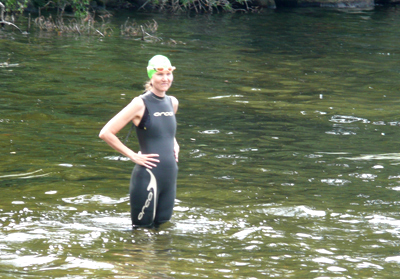
Johanna by Jed Schwartz
Johanna's Swim!
On August 27th, Conservation Commission and Energy Committee
member Johanna Young swam the length of Millen Pond as a memorial
to Rich Cook and to bring some recognition to water quality
issues. She enjoys competeing in triathlons and thought this
swim would be a great way to use her swimming skills to raise
awareness about water quality and conservation in our lakes
in Washington.
She began her swim at the town beach at Camp Morgan and swam
along the town forest side of the lake.
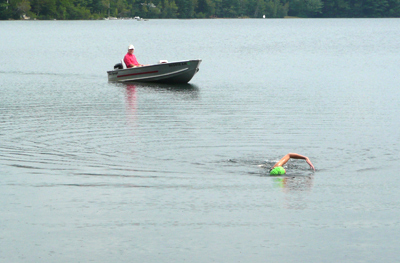
She was accompanied by Millen Pond resident Dennis O'Malley,
in his boat, carrying supplies and ready to help Johanna if
needed. Jed and Nan also followed along in their canoe to
take pictures and give encouragement to her. One of the Millen
Pond loons swam along most of the way to keep an eye on things
and comment periodically on the action taking place in his
lake!
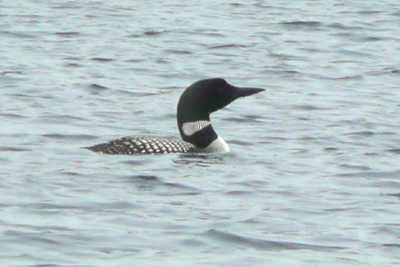
There was a hurricane expected to arrive on Sunday but luckily
Saturday turned out to be a beautiful day for Johanna's swim.
It was quiet and peaceful on the lake with most of the lake's
boats already secured for the coming storm.
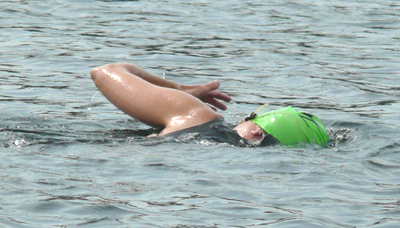
The swim took about and hour and ended at the Brighton's beach
at the far end of Millen Pond. Congratulations Johanna!!
You did it.
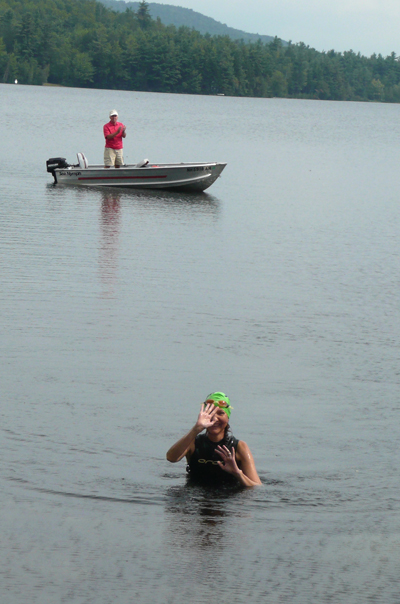
In future years, Johanna hopes to swim the length of each
of the lakes in Washington and then move on to other lakes
in our region. She would love to have other swimmers join
her next year.
If you would like to make a donation in honor of Johanna's
swim, please send a check to the Conservation Commission
with "memorial swim" in the memo line. Donations can be sent
to Conservation Commission, 7 Halfmoon Pond Road, Washington,
NH 03280.
A special thank you to Dennis O'Malley for coming along and
supporting Johanna's swim!
July:

Loon Family Picture by Charles
Johnson
Wildlife in Washington!
With all the recent wildlife sightings in Washington reported
by Conservation Commission members this month, we thought
we would share some wildlife pictures and video we have received
from people around town. See our minutes for more sightings:
WCC July minutes
We received these wonderful shots of loons
on Island Pond from Charles Johnson, including the one above.
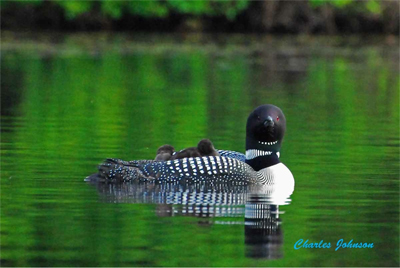
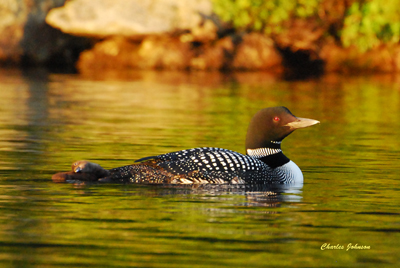 . .
Here's a treat from Ed Thayer, he caught a bear on video,
swimming in a pond in East Washington! Click here to view:
Ed's
YouTube video of a bear
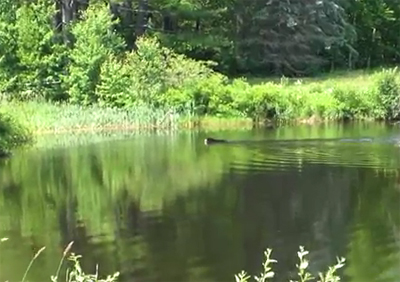 Here is a video of a grouse, also caught by Ed Thayer, click
here to view:
Ed's grouse movie
Here is a video of a grouse, also caught by Ed Thayer, click
here to view:
Ed's grouse movie
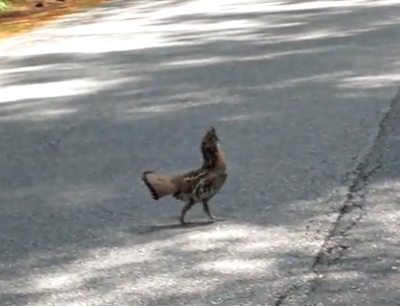
Ed has quite a few videos he has posted of his farm and animals,
too. You can find the links for them at either of these you
tube links, he posts them under the name "whighway".
Enjoy!
Ed caught this beautiful water snake near
Carol's culvert.
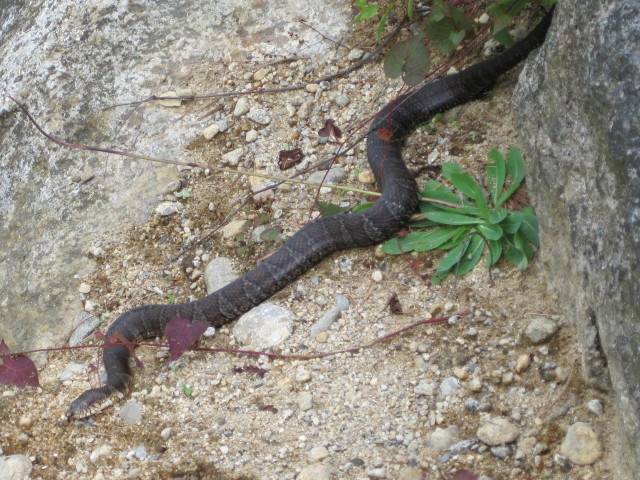
The Paquin family captured a bear who visited
their back porch in East Washington, looking for goodies.
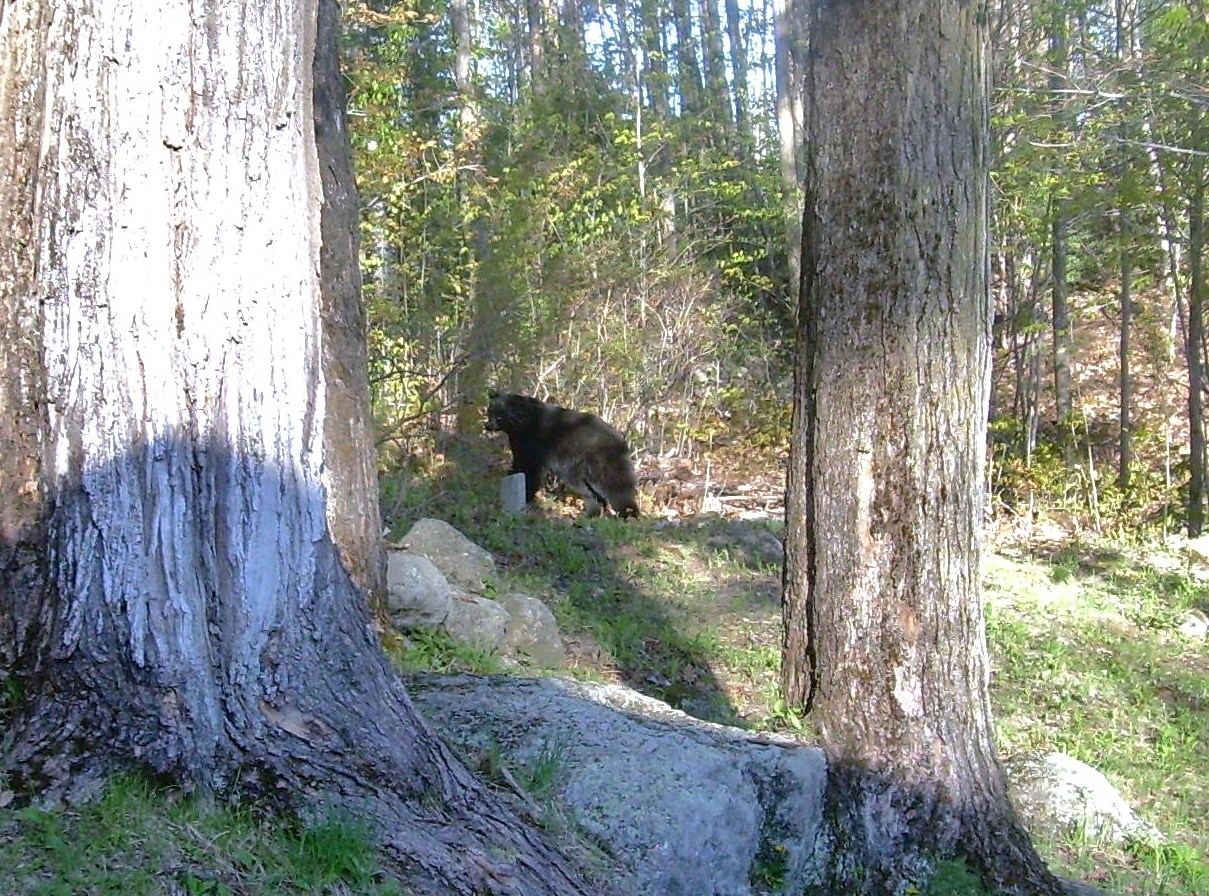
While on patrol around town our police chief Steve Marshall
always has his camera handy for wildlife shots like these:
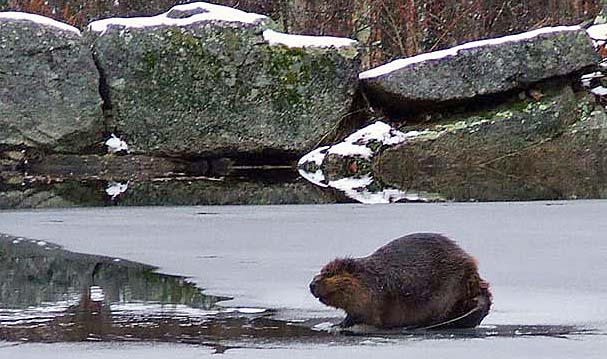
Mr. Beaver
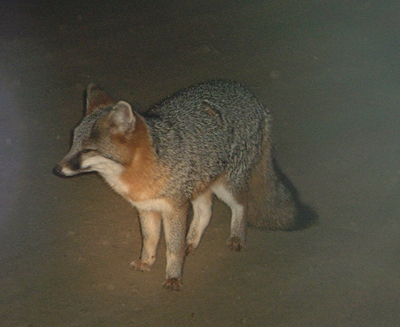
Mr. Red Fox
It's not wildlife but here's a pretty shot of a rainbow
over the middle of Washington by Tom Noonan:

Johanna Young's lovely picture of a Luna moth:
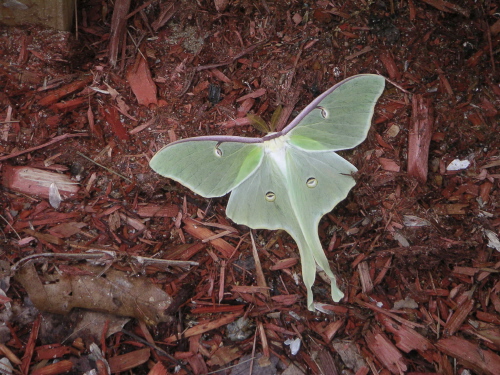
A magnificent Bald Eagle that Robin Collins
photographed in a tree near Parker's Point on Millen Pond:

The glowing eyes of a Fischer were caught
by Becky Denslow last winter:
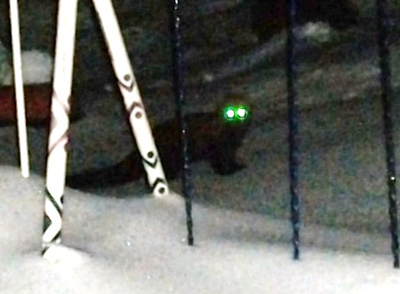
The Washington town website has even more pictures to see,
click here for the:
Washington Wildlife page
Thank you to everyone who gave us their wildlife shots to
use! Have you seen any wildlife recently that you want us
to know about? Email us your pictures to this address:
WCC email
June:
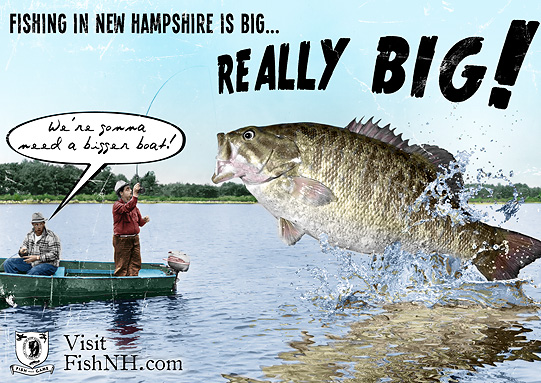
Postcard from
NHFG
Time to go Fishing!
Fishing season is open and Washington has many great spots
for angling. New Hampshire Fish and Game has all kinds of
information and resources to help get you out there catching
fish. The following are helpful links from their website:
Fishing
in New Hampshire
• Weekly
fishing Reports - find out what is being caught and where
• Public
access maps - find a public boat launch
• Fish
Stocking report - find out where F&G has stocked in the
past week
• Tips
on how to fish - all you need to know about fishing techniques
and how to tips
• Get a 2011 fishing license on-line - print it out for immediate use
• Depth
maps for Washington ponds - find the sweet spots
• Be
aware of aquatic nuisance species - take action to protect
our water bodies
• Guidelines
for eating fish safely - use extra precaution for fish
caught in May Pond and Ashuelot Pond because of high mercury
levels. Note: stocked trout are always safe to eat.
• Information
on using non-lead sinkers and jigs - help protect Loons
and other water birds
Whether you catch and release or eat them for dinner - good
luck and happy fishing!
Here's a treat from Ed Thayer, he caught a bear on video,
swimming in a pond in East Washington! Click here to view:
Ed's
YouTube video. He's also got some other videos from his
farm at the same link. Enjoy!
May:
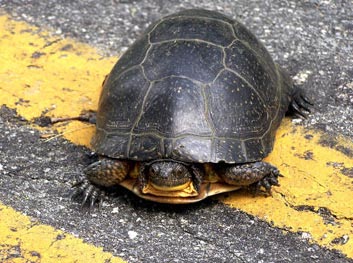
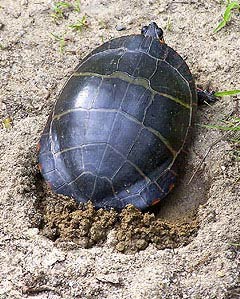
Picture by Mike
Marchand NHFG
Picture
by Mike Marchand NHFG
Watch Out, Turtles Crossing!
Spring is a welcome time in New Hampshire, and one of the
signs of the season is turtles migrating to nesting habitat.
We can help them survive by slowing down and keeping an eye
out for turtles crossing the roads in coming weeks. Turtle
nesting season in New Hampshire typically lasts from late
May into early July, reaching maximum intensity in early to
mid-June. Today, the biggest threat to turtle populations
in New Hampshire is being struck by automobiles on roadways.
To find an appropriate nesting habitat, female turtles may
travel several hundred yards or more, seeking a sandy or other
well-drained area that is open to sunlight.
Predators are generally not catastrophic for local populations
but the impact of development and the associated increase
in amount and speed of traffic on our roads is taking a toll.
Here are a few things you can do to help New Hampshire
turtles survive:
• Slow down and watch for turtles in roadways!
• Help turtles cross roads safely. If you see a turtle crossing
a road, and it is safe for you to do so, help it cross in
the direction it was traveling. Never create a dangerous
situation for other motorists or yourself. Snapping turtles
should be handled with care or allowed to cross on their own.
• Don't take the turtle home or move it far from where you
found it. A turtle taken to your home is a turtle lost from
the local population. (Also, all New Hampshire native turtles
are protected by state law during nesting season).
• If a turtle is injured, visit wildlife
rehabbers.com or call Fish and Game's Wildlife Division
at (603) 271-2461 for a list of wildlife rehabilitators in
your area. For more on what to do if you find an injured turtle,
visit NH
Wildlife - Injured Turtle.
• Report turtle sightings to N.H.
Fish and Game's Reptile and Amphibian Reporting Program.
• Work with land trusts and town officials to help conserve
important natural areas in your community.
• Another tip: Mulch piles can be attractive places for turtles
to nest when located near wetland areas. Spreading mulch
into gardens soon after delivery will reduce turtles from
nesting in a mulch pile that is likely to be disturbed later
in the season. If mulch will be in place for several weeks
or more, covering with plastic will help reduce attractiveness
for nesting turtles.
By taking these steps, we can all help to ensure that New
Hampshire's turtles stay abundant and healthy. So slow down
and give turtles a brake this spring and summer!
Information from NH
Fish and Game
April:
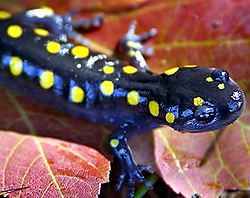
Picture by Victor
Young NHFG
Arin brought us a beautiful pair of Spotted Salamanders
to look at during our meeting. She found them crossing the
road at night on their way to a vernal pool.
The Spotted Salamander is a large dark salamander measuring
4.5-7.5 inches. The base color is generally black or bluish-black
and it has up to 50 round yellow or orange spots arranged
irregularly down the back and sides.
It is found throughout NH in mixed woodlands with slow moving
streams, swamps, or vernal pools. The adults spend their time
underground or under logs, boards, or stones in hardwood forests
and on hillsides. At night they will emerge to feast on insects
and other invertebrates. It uses its sticky tongue to catch
worms, insects, and snails. Some spotted salamanders can live
to be 30 years old!
Warm, rainy spring nights after the winter thaw, between mid-March
and the end of April, trigger a mass migration to their isolated
breeding pools. They usually breed in vernal pools because
they do not contain predatory fish. Once there, they breed
and the females lay several jelly masses containing 100-200
eggs, which are attached to submerged sticks and vegetation.
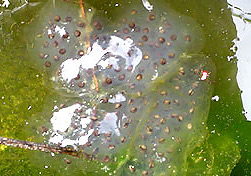 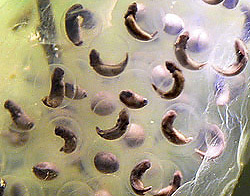
Picture by Trombley/USDAFS
Picture by
Victor Young NHFG
The larvae hatch in one to two months, depending on the water
temperature. They look something like dull, yellow-green speckled
tadpoles, with long feathery gills protruding from their heads.
They spend the better part of the spring and summer growing
into their legs and feasting on the many aquatic insects in
the vernal pools, becoming salamanders in two to four months.
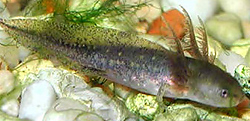
Picture by
Dan Drake USGS
By the time the vernal pool dries up, they are ready to use
their lungs rather than gills. They set out to find their
new terrestrial home, usually within a few hundred feet of
the now empty vernal pool.
The rest of their year is spent hibernating in the ground
or under rotting stumps.
Spotted salamanders are particularly sensitive to development.
Destruction of vernal pools will interfere with breeding,
while destruction of forests within a half-mile radius of
the pools will destroy adult habitat. Roads are particularly
dangerous during their migratory seasons. Do your part to
protect salamanders by being aware of vernal pools and protecting
them from development.
Come visit a vernal pool on Faxon Hill Road with the
Conservation Commission on May 7th at 11AM. Wear
your boots and be prepared to see all kinds of creatures.
Call a member for more details.
Information found at:
New Hampshire Fish and Game, NHPT
and Heart
of New England.com
March:
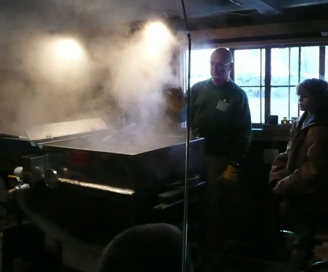
Picture by Jed Schwartz
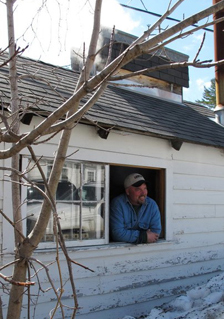 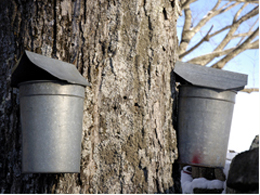
Picture by Sue Hofstetter
Picture from
UNH
It’s Maple Sugaring time!
This wonderful and delicious gift from nature comes only once
a year and now is the time to enjoy it. The maple trees are
tapped and sap is boiling in the sugarhouses.
Maple sugaring time in New Hampshire runs from mid-February
to mid-April and the maple season usually lasts 4-6 weeks.
The days and length of the sap runs depend entirely on the
weather. As the frozen sap in the maple tree thaws, it begins
to move and build up pressure within the tree. When the internal
pressure reaches a certain point, sap will flow from any fresh
wound in the tree. Freezing nights and warm sunny days create
the pressure needed for a good sap harvest.
In late February, New Hampshire maple producers tap their
sugar maples by drilling a small hole in the trunk and inserting
a spout. A bucket or plastic tubing is fastened to the spout
and the crystal clear sap drips from the tree. It is then
collected and transported to the sugar house where it is boiled
down in an evaporator over a blazing hot fire. As the steam
rises from the evaporator pans, the sap becomes more concentrated
until it finally reaches the proper density to be classified
as syrup. It is then drawn from the evaporator, filtered,
graded and bottled. It takes approximately forty gallons of
sap to make one gallon of pure maple syrup.
We hope you will visit a sugar house during the maple season
and learn for yourself just how this ancient tradition is
carried on. New Hampshire's maple producers take great pride
in the high quality of their maple products.
Washington has several local sugarhouses to visit including:
Fletcher & Family Sugar House, Ed & Jane
Thayer, at 2528 E. Washington Rd. in East Washington
Atkins Family Sugar House, Shawn & Kathy
Atkins, at 504 South Main St. in Washington
Crane Farm, South Main Street in Washington
There are many back yard sugaring operations to visit, as
well. Don't delay, the season won't last for too much longer.
Make a plan to get outside, enjoy the warm spring weather,
watch the sugaring fun and get your supply of fresh maple
syrup!
Information found at: NH
Maple Producers
February:
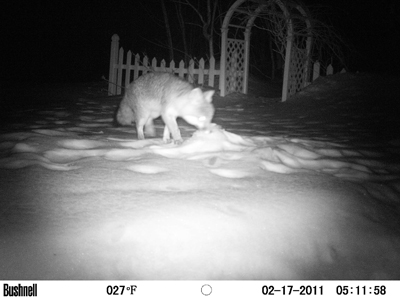
Trail Camera picture by Ken Eastman
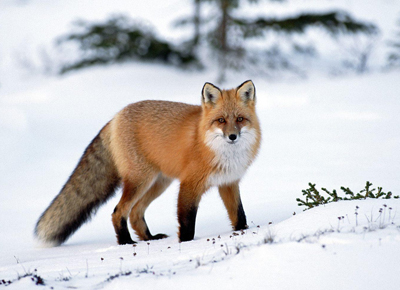
Red Fox picture Animal Pictures for Kids
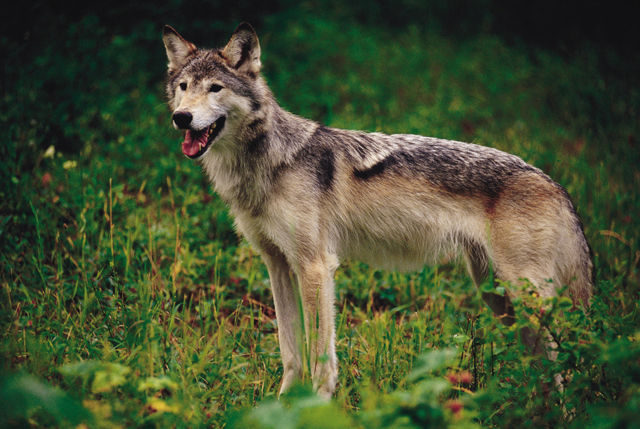
Coyote picture by UNH
What Am I?
Ken got a new trail camera and captured this picture the first
night! He and Charley have had a beautiful Red Fox
living in the base of an old hollow maple tree behind their
house and hoped to get a picture of it. At first glance they
weren't sure if the picture showed a fox or a coyote but in
comparing the pictures above, I think they definitely got
their fox! He was attracted to this spot by spilled bird seed
and squirrels living in the snow holes.
A glimpse of a cherry-red fox against the backdrop of snow-covered
fields is a sight to behold. Both red and gray foxes live
in the Granite State, but the red fox is far more abundant
and has a widespread range. Gray foxes are more common in
southern New Hampshire, and are rarely recorded in Coos County.
Unlike red foxes, gray foxes (which can climb trees) are able
to co-exist with coyotes.
The larger of the two foxes, the red fox has a sleek, lean
appearance, compared to the more stout and robust gray fox.
The red fox is generally reddish, though shades may vary,
and has a distinct white tip on its tail. The gray fox has
a line of black-tipped fur down its back. The upper part of
its gray coat is grizzled with guard hairs banded with gray,
black and white; the under parts range from light-colored,
buff and white to reddish. The gray fox's tail is tipped with
black.
The gray fox prefers more wooded and brushy habitat, while
its cousin, the red fox, inhabits fields and farm country.
Gray foxes have always been here, but have never been as numerous
as red foxes. The gray fox's diet changes with the season,
ranging from grasshoppers, grapes and apples in the summer
months, to small mammals like mice, voles and squirrels at
other times of year. In the last decade, New Hampshire trappers
have taken about 100 gray fox each year.
Like gray foxes, red foxes can eat a variety of foods, including
insects and fruit. They are well known for capturing mice
and voles, which generally make up most of their diet. They
will also eat larger prey, such as woodchucks, rabbits and
the occasional housecat.
For many years, hunting red fox with hounds was a favored
sport. In the 1930s and 1940s, as many as 5,000 foxes were
taken in New Hampshire each year. Today, hunters take only
a dozen or two foxes each year, and trappers have harvested
an average of 310 red foxes a year over the past ten years.
- Eric Orff, Wildife Biologist
Information found at: NH
Fish and Game
January:
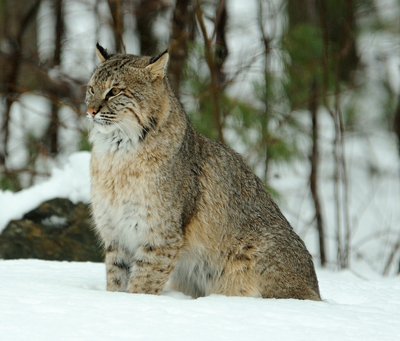
Bobcat picture Diane Low
Jed and a neighbor both spotted a bobcat
recently in East Washington. It was a big and very beautiful
cat!
Historically this area has been known to have bobcats and
has suitable habitat for them. Bobcats are associated with
uplands or wetlands with dense understory vegetation, and
rugged terrain that may include rocky outcrops. The Sunapee
Highlands offer this kind of habitat with a large area of
protected land where they can move around safely.
Mature males can weigh over 30 pounds, and mature females
are usually close to 20 pounds. Because of this size difference,
males can be effective at capturing large prey, including
deer. Juveniles (males and females) and adult females because
of their smaller size must rely on small prey, especially
rabbits and gray squirrels, a variety of mice, voles and shrews.
Their coats, in summer, tend to be tawny brown with obvious
areas of red. In winter, their thicker coats lean toward slate
gray.
Bobcats are a protected species, and trapping and hunting
seasons in New Hampshire have been closed since 1989.
Although secretive, bobcats can be detected where they live.
With snow on the ground, tracks can be a fairly reliable indication
that there is a bobcat hunting your woodlot. Bobcats have
very round feet compared to wild coyotes and dogs.
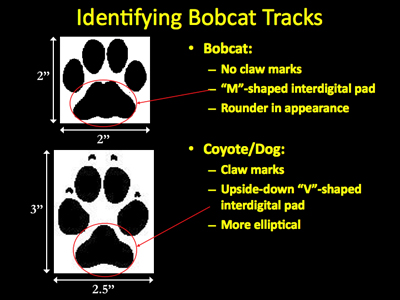
Track picture UNH.edu
In addition to shape and size of their tracks (house cat tracks
are much smaller), the stride of a bobcat is usually shorter
than that of a coyote.
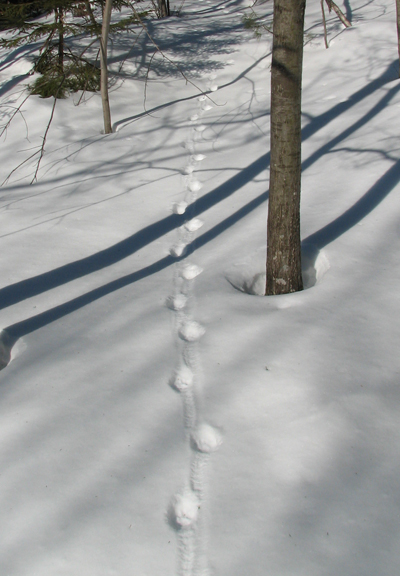
Track picture UNH.edu
If you have the opportunity to track a bobcat and coyotes
or foxes, you are likely to see some differences in their
respective behaviors. Foxes and coyotes will often walk along
logging roads for considerable distances, whereas bobcats
will often just cross them. On the other hand, young bobcats
may walk on top of fallen trees and logs whereas foxes and
coyotes won't.
UNH has a cooperative project with New Hampshire Fish and
Game to track bobcats and learn more about their distribution
around the state.
Keep your eye out for this beautiful and fascinating cat and
report your sightings here:
UNH Bobcat Sightings Website
Information found at: UNH Bobcat Project Website and NH Wildlife Plan Website
To view yearly archives of our "New In
Nature" series click on year you wish to see.
2002
2003
2004
2005
2006
2007
2008
2009
2010
2011
2012
|


